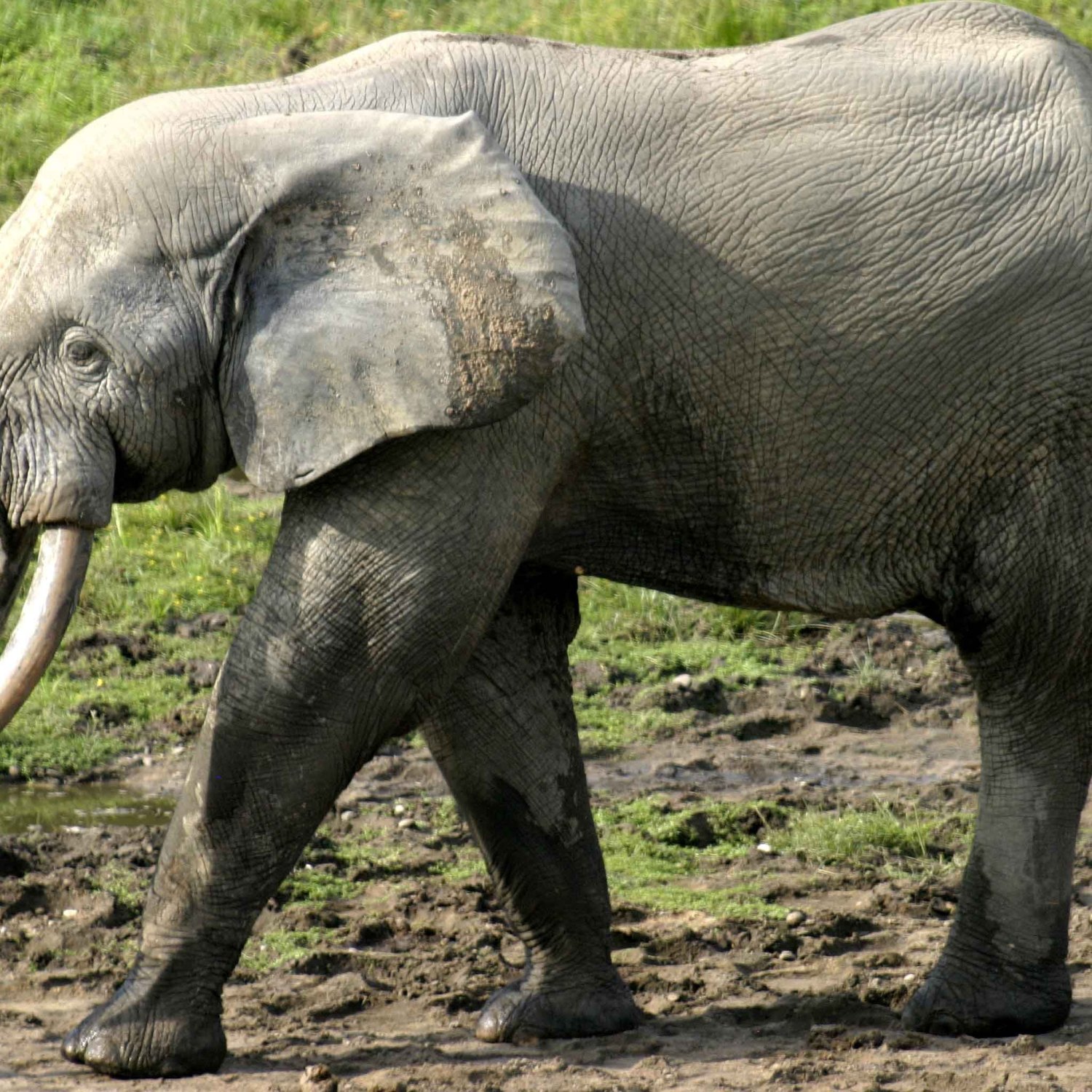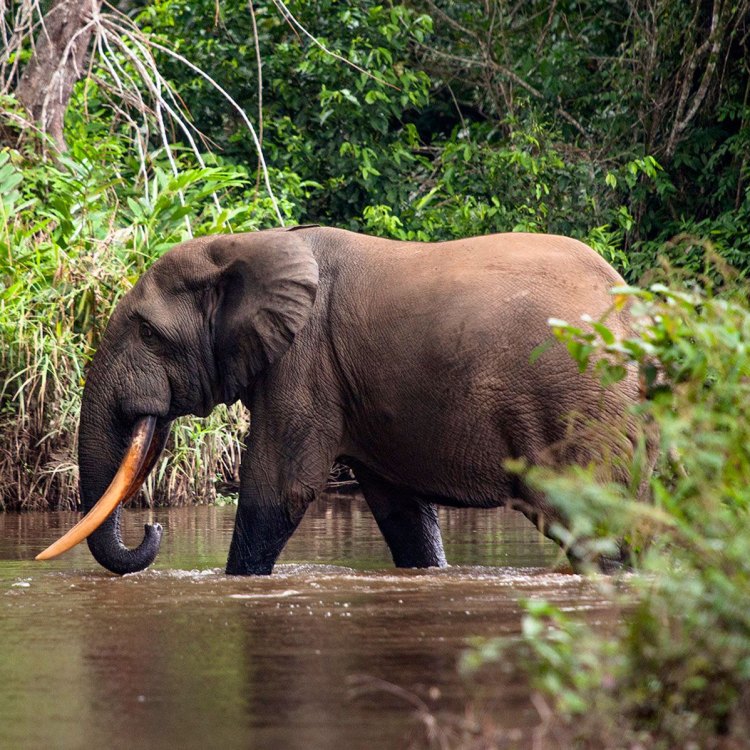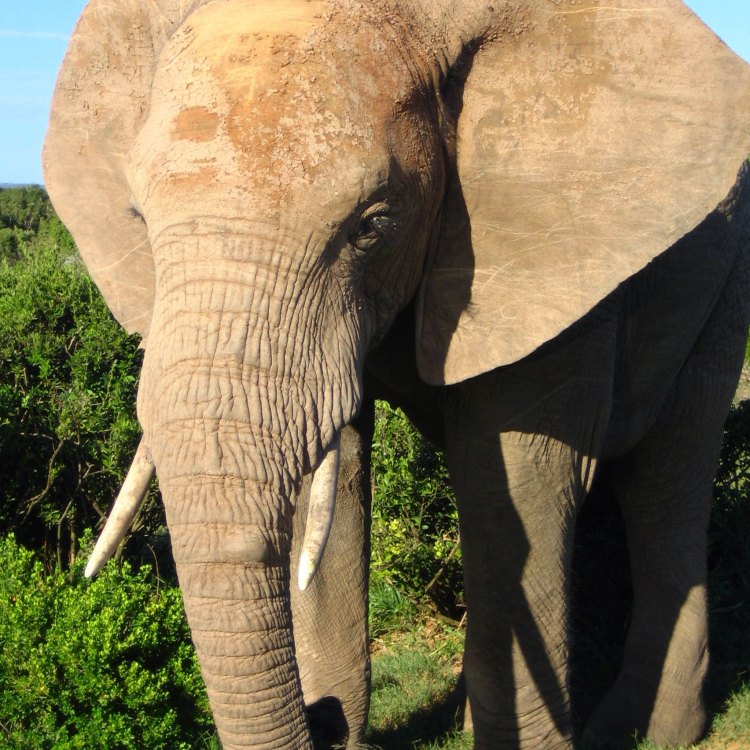
African Forest Elephant
2.5-3 meters (8-10 feet)
The African Forest Elephant is a majestic mammal that belongs to the family Elephantidae. It can grow up to 2.5-3 meters in length and is found in various countries in Central and West Africa. With its large and stocky body, it is a vital part of the ecosystem. Let's do our part in protecting these gentle giants. #AfricanForestElephant #Conservation #Wildlife #Elephantidae
Animal Details Summary:
Common Name: African Forest Elephant
Kingdom: Animalia
Habitat: Tropical rainforests and dense forest areas
The Majestic African Forest Elephant: Navigating the Lush Rainforests of Central and West Africa
Deep within the heart of the African continent lies a treasure trove of wildlife, with creatures big and small calling it home. Among these creatures, one stands out in its sheer size, intelligence, and presence – the African Forest Elephant.Also known as the Loxodonta cyclotis, the African Forest Elephant is a stunningly awe-inspiring mammal that roams the tropical rainforests and dense forest areas of Central and West Africa. Its scientific name derives from the Greek words "loxos," meaning slanting, and "odous," meaning tooth, referring to the elephant's unique and slanting molars African Forest Elephant. This magnificent creature is not just a sight to behold, but it is also a crucial contributor to the ecology and biodiversity of its habitat.
In this article, we will take a closer look at the African Forest Elephant and uncover the many wonders of this gentle giant.
The African Forest Elephant: A Species in Need
The African Forest Elephant is a member of the Animalia kingdom, Chordata phylum, and Mammalia class, placing it among some of the most advanced creatures on the planet. It is part of the Proboscidea order, meaning "having a trunk," which includes other species like the African Savannah Elephant and the Asian Elephant. The African Forest Elephant is part of the Elephantidae family, which includes all elephant species.One of the most striking features of the African Forest Elephant is its habitat. Unlike its Savannah counterpart, this elephant is not found in open grasslands but instead navigates through the lush green canopies of the tropical rainforests and dense forests. These areas provide ample vegetation and water sources for the elephants to thrive.
Unfortunately, due to habitat loss and poaching, the African Forest Elephant is currently listed as a vulnerable species on the International Union for Conservation of Nature (IUCN) Red List, with a decreasing population trend American Foxhound. Conservation efforts are critical in ensuring the survival of this species, as they play a vital role in maintaining the intricate balance of the rainforest ecosystem.
Feasting on the Bounties of the Rainforest
The African Forest Elephant is a herbivorous animal, feeding primarily on leaves, fruits, and bark. These gentle giants consume a significant amount of vegetation, with an estimated 225 kilograms (500 pounds) of plant material eaten every day. Their diet helps in the dispersal of seeds and the growth of new plant life, making them critical players in the rainforest's survival.In fact, studies have shown that elephants play a crucial role in shaping and maintaining the rainforest ecosystem. They create pathways for smaller animals and aid in the survival of other plant species by feeding on certain vegetation, keeping it in check. Without elephants, there would be a significant impact on the biodiversity and overall health of the rainforest.
Geographical Distribution and Country of Origin
The African Forest Elephant's geographical distribution is mainly limited to the countries of Central and West Africa. Some of the countries where they can be found include Cameroon, Gabon, Congo, and the Central African Republic. They also have a presence in some parts of Nigeria, Equatorial Guinea, and the Democratic Republic of the Congo.These elephants have adaptations that allow them to thrive in the different environments of their range. For example, they have smaller ears compared to their Savannah counterparts, which helps them navigate through dense forest areas. They also have longer and thinner tusks, making it easier for them to maneuver around trees and shrubs.
Appearance and Physical Characteristics
The African Forest Elephant has a distinct appearance, differentiating itself from other elephant species. One of the most noticeable characteristics is its smaller size, with adults measuring between 2.5-3 meters (8-10 feet) in length and weighing between 2,000-5,000 kilograms (4,400-11,000 pounds). They also have a stockier build and are darker in color compared to other elephants, with shades ranging from dark grey to brown.Another unique feature of the African Forest Elephant is its trunk, which has two prehensile tips instead of one. This adaptation allows them to have a more precise grip on objects, making it easier for them to grab and manipulate food. The trunk also serves as a snorkel when the elephant is submerged in water, allowing it to breathe.
A Threatened and Protected Species
As mentioned earlier, the African Forest Elephant is currently listed as a vulnerable species and faces risks such as habitat degradation, poaching, and human-elephant conflict. One of the main threats to this species is poaching for its tusks, which are highly valued for their use in the ivory trade.Since the early 2000s, the population of African Forest Elephants has decreased by over 62%, making them one of the fastest-declining mammals on the planet. To combat this issue, conservation efforts have been implemented to protect these animals and their habitat. Organizations such as the World Wildlife Fund (WWF) work closely with local communities and governments to raise awareness and implement sustainable solutions to protect this species.
The Importance of Research and Technology
To better understand and conserve the African Forest Elephant, researchers and conservationists have utilized various methods, such as tracking collars and camera traps, to collect data. This information helps in understanding their migration patterns, feeding behaviors, and overall population status.Advancements in technology, such as AI and machine learning, have also been used in research efforts. For example, scientists have developed elephant call recognition technology that can detect and identify the different vocalizations of elephants. This technology has proved useful in monitoring and tracking elephant populations in remote areas, providing valuable data for conservation efforts.
The Threat to Elephant Habitats
The African Forest Elephant is not the only elephant species facing threats to their habitat. The encroachment of human activity and development poses a significant risk to both elephant populations and their habitats. Deforestation, mining, and agriculture expansion are just some of the factors that contribute to destroying elephant habitats and disrupting their way of life.However, initiatives such as responsible eco-tourism and sustainable forest management practices can help mitigate these threats. By providing alternative income sources for local communities and promoting fair trade practices, these initiatives can help protect the habitats of African Forest Elephants and other wildlife.
A Brighter Future for the African Forest Elephant
Despite the challenges that the African Forest Elephant faces, there is hope for the future. Conservation efforts, advancements in technology, and responsible practices can all contribute to the protection and preservation of this magnificent species.But it is not just up to conservation organizations and governments to ensure the survival of the African Forest Elephant. Each one of us can play a role in protecting and preserving these gentle giants by being mindful consumers, spreading awareness, and supporting ethical and sustainable practices.
As we continue to learn more about these wonderful creatures and their vital role in the rainforest ecosystem, we can also appreciate their beauty and majesty. The African Forest Elephant is not just a symbol of the African continent, but a symbol of the delicate balance between humans and wildlife, and the importance of our planet's biodiversity.

African Forest Elephant
Animal Details African Forest Elephant - Scientific Name: Loxodonta cyclotis
- Category: Animals A
- Scientific Name: Loxodonta cyclotis
- Common Name: African Forest Elephant
- Kingdom: Animalia
- Phylum: Chordata
- Class: Mammalia
- Order: Proboscidea
- Family: Elephantidae
- Habitat: Tropical rainforests and dense forest areas
- Feeding Method: Herbivore
- Geographical Distribution: Central and West Africa
- Country of Origin: Various countries in Central and West Africa
- Location: Various countries in Central and West Africa
- Animal Coloration: Dark grey to brown
- Body Shape: Large and stocky
- Length: 2.5-3 meters (8-10 feet)

African Forest Elephant
- Adult Size: Adult bulls can reach a shoulder height of up to 3 meters (10 feet) and weigh around 2,000-6,000 kilograms (4,400-13,200 pounds). Adult cows are slightly smaller.
- Average Lifespan: Up to 60-70 years
- Reproduction: Sexual
- Reproductive Behavior: Polygynous (males mate with multiple females)
- Sound or Call: Vocalizations include low-frequency rumbles, trumpeting, and screams
- Migration Pattern: No regular migration pattern
- Social Groups: Live in small family groups led by a matriarch
- Behavior: Generally peaceful and non-aggressive, but can become aggressive if threatened
- Threats: Habitat loss, poaching for ivory, human-wildlife conflict
- Conservation Status: Endangered
- Impact on Ecosystem: Play a crucial role in shaping the structure and diversity of the forests
- Human Use: Poaching for ivory, habitat destruction
- Distinctive Features: Relatively straight tusks, rounded ears, and smaller size compared to African savanna elephants
- Interesting Facts: African Forest Elephants are the smallest and darkest of the three elephant species and have unique physical and behavioral adaptations to their forest habitat.
- Predator: Natural predators are not common, but may include lions and crocodiles.

Loxodonta cyclotis
African Forest Elephant: Guardians of the Forest
As the largest land mammal on Earth, the elephant needs no introduction. They are iconic animals, known for their immense size and intelligence. However, most people are only familiar with the African savanna elephant, found in the vast open plains of Africa. But there is another, lesser-known elephant species that calls the dense and diverse African forests its home – the African Forest Elephant PeaceOfAnimals.Com.What sets the African Forest Elephant apart from its savanna-dwelling counterpart is not just its habitat, but also its physical and behavioral adaptations. This magnificent creature is a prime example of how evolution can mold a species to thrive in its specific environment.
An Impressive Size and Lifespan
The African Forest Elephant, scientifically known as Loxodonta cyclotis, is the smallest of the three elephant species and has a distinctively darker coat. An adult bull can reach a shoulder height of up to 3 meters (10 feet) and weigh around 2,000-6,000 kilograms (4,400-13,200 pounds), while adult cows are slightly smaller.These giants of the forest have an average lifespan of 60-70 years in the wild. Their longevity can be attributed to their intelligence and the lack of natural predators in their habitat. They are also known to have strong social bonds, which contribute to their overall well-being and survival.
Reproduction and Social Behavior
Like all elephants, African Forest Elephants are sexual and reproductive behaviors are similar to those of their savanna relatives. However, due to their habitat, they have adapted a unique reproductive behavior known as polygyny Airedale Terrier. This means that males mate with multiple females, which helps increase genetic diversity and ensures the survival of their species.African Forest Elephants live in small family groups led by a matriarch. These groups are usually made up of related females and their young, with occasional visits from adult males during the mating season. This social structure is essential for their survival, as it helps ensure the protection and care of the young and strengthens the bond between family members.
Sounds of the Forest
If you ever find yourself in the African forest, you may be able to hear the deep, low-frequency rumbles, trumpeting, and screams of the African Forest Elephant. These vocalizations are used for communication between family members and can travel through long distances in the dense forest. They also play an important role in maintaining social bonds and establishing dominance within the group.Behavior and Migration
Despite their impressive size, African Forest Elephants are generally peaceful and non-aggressive animals. They prefer to avoid conflict and try to resolve disputes through displays of strength and vocalizations. However, they can become aggressive if they feel threatened, especially when protecting their young.Unlike their savanna relatives, African Forest Elephants do not have a regular migration pattern. Instead, they have a more sedentary lifestyle, moving only in search of food and water. This is why they are often referred to as "stay-at-home" elephants.
Threats to Survival
Unfortunately, the African Forest Elephant is facing several threats that jeopardize its survival. Habitat loss is a major concern, as the forests are being cleared for agriculture and urban expansion. This not only decreases their living space but also hinders their ability to move and find food, leading to malnourishment and death.Another severe threat is poaching for ivory. The ivory tusks of African Forest Elephants are smaller compared to savanna elephants, but they are still targeted by poachers for the illegal ivory trade. This, coupled with the slow reproductive rate of elephants, has led to a decline in their population.
Moreover, human-wildlife conflict is also a significant problem for these gentle giants. As their habitat shrinks, elephants are forced to move closer to human settlements in search of food and water, leading to conflicts and sometimes fatal consequences for both humans and elephants.
Conservation Efforts and Ecosystem Impact
Due to these threats, the African Forest Elephant is currently listed as Endangered on the IUCN Red List. Various conservation organizations and governments are working towards protecting these magnificent creatures and their habitat. Strategies such as increasing anti-poaching efforts, creating protected areas, and promoting sustainable land-use practices are crucial for their survival.Apart from their importance in terms of biodiversity and maintaining the balance of forest ecosystems, African Forest Elephants play a crucial role in shaping the structure and diversity of the forests. As they move through the forest, they create clearings, uproot trees, and disperse seeds, playing an integral part in the regeneration and survival of the forest.
Human Use and Distinctive Features
Humans have had a significant impact on African Forest Elephants, both positive and negative. Apart from poaching for ivory, elephants are also hunted for their meat and used in traditional medicines. Habitat destruction and human-wildlife conflict also heavily impact their survival.One distinctive feature of the African Forest Elephant is its relatively straight tusks, which sets it apart from its savanna relative, whose tusks tend to curve outwards. They also have rounded ears, which provide them with better camouflage in the dense forest, and are generally smaller in size compared to savanna elephants.
Interesting Facts
-African Forest Elephants are the smallest and darkest of the three elephant species.-Their skull is specially adapted to help them maneuver in the dense forest, with a more extended snout and flatter forehead.
-To avoid overheating in their hot and humid habitat, African Forest Elephants have more sweat glands than savanna elephants, allowing them to release heat through their skin more efficiently.
-Some scientists believe that African Forest Elephants may be a separate species from the savanna elephant due to their genetic differences and unique adaptations.
Predators
Natural predators of the African Forest Elephant are not common, but they may include lions and crocodiles. However, adult elephants are rarely preyed upon, and their sheer size and strength make them a formidable opponent for most predators.In conclusion, the African Forest Elephant is an incredible and unique species that deserves our attention and protection. It is a living example of how evolution can shape a species to thrive in its specific environment and highlights the importance of preserving diverse habitats for the survival of all species. By taking action now, we can ensure that these gentle giants continue to roam the forests for generations to come.

The Majestic African Forest Elephant: Navigating the Lush Rainforests of Central and West Africa
Disclaimer: The content provided is for informational purposes only. We cannot guarantee the accuracy of the information on this page 100%. All information provided here may change without prior notice.












